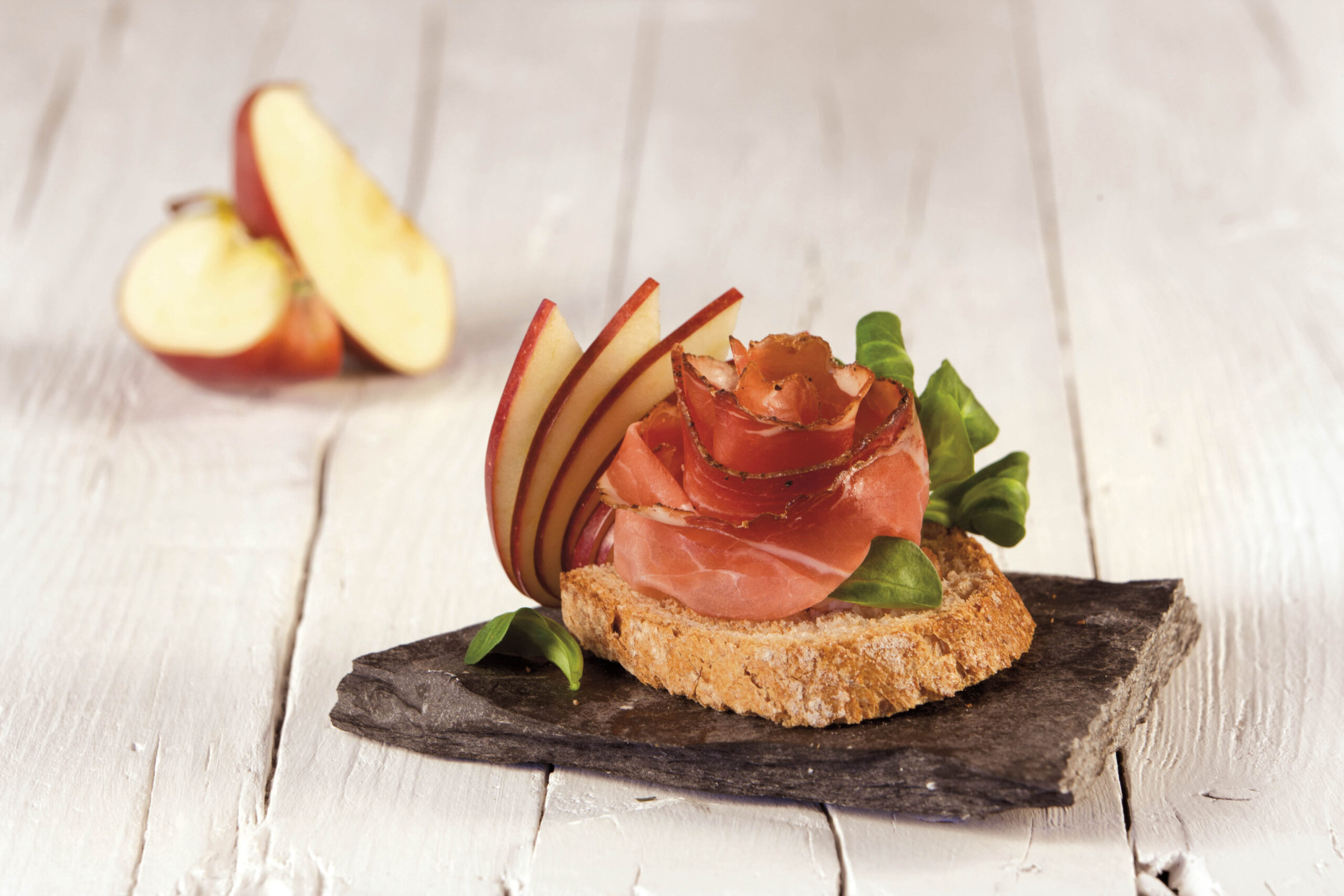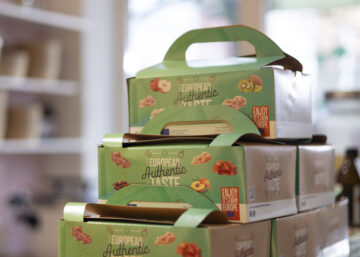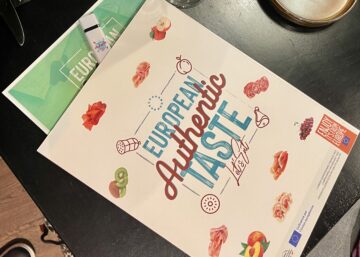The “Restaurant Weeks” in Belgium, promoted by the Istituto Valorizzazione Salumi Italiani (Institute for the Valorization of Italian Cold Cuts) and ASIAC – the Association formed by the eight largest organisations of Greek fruit producers, in collaboration with the Italian Association of the Ambassadors of Taste, will start from 3 to 17 March.
The Let’s EAT – European Authentic Taste project will take place in 10 carefully selected restaurants and pizzerias throughout Belgium. The project includes a tasting of Italian deli meats and Greek fruit, both natural and cooked.
Inside the restaurants and pizzerias, customers will receive a fun and colourful album of Panini Group stickers where the cold cuts and fruit are accompanied by portraits of the four Ambassadors of the project, chosen as testimonials of Let’s EAT for their philosophy of life, full of style and energy: Carlo Cracco (chef and television personality), Matteo Eydallin (World Champion of Ski Mountaineering), Paola Fraschini (World Champion in artistic roller skating), Tanya Gervasi (model and food blogger). In addition to this gadget, where people will compete to stick on the 32 colourful and very ‘pop’ stickers, those who go to the restaurants will also be able to receive a ‘foodie bag’ containing a sample of cured meats and fruit; a way of continuing the the journey of tastes at ‘home’.
But who are the protagonists of this journey into taste?
The protagonists of this journey into taste will be:
– Monella, a characteristic Italian street food counter;
– Racines an Italian street food counter in Brussels ;
– Ci piace an Italian restaurant & cocktail bar in Brussels ;
– Al Bacio a typical Puglia pizzeria in Brussels ;
– Notos a Greek restaurant, in Brussels ;
– Palette a natural wines & small plates to share – seasonal cuisine in Brussels ;
– Joli Jam a seasonal cuisine in a trendy hotel in Brussels ;
– Humphrey a Filipino inspired cuisine in Brussels ;
– IΔEA a Greek sharing experience in Brussels ;
– CoinCoin a fresh pasta bistro in Woluwé-Saint-Pierre.
A series of tastes and flavours that will surprise the consumer when they see unique and original combinations.
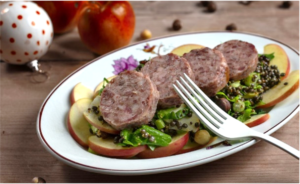
Recipe: Lentil, cotechino and apple salad
1 – Cook the cotechino, let it cool and then cut it into regular slices;
2 – Boil the lentils in lightly salted water, drain well when al dente and leave to cool;
3 – Pour the dehydrated blueberries into a bowl and sprinkle with rum; carefully wash the apples and slice them without peeling, then keep them in a bowl soaked in lemon juice;
4 – Wash the celery, remove the leathery filaments and cut it into even pieces;
5 – Place the lentils in a large bowl, dress with the extra virgin olive oil and then with the mustard seeds, mix well;
6 – Add the celery, toasted hazelnuts, blueberries drained from the rum, apples and if you like cinnamon; mix everything together;
7 – Arrange the salad on a plate and place the slices of cotechino on top.
Let’s move on to the second recipe: a combination of plums and bacon, a great classic among aperitifs and finger foods but which in the version from La Cucina di Calycanthus has a few more creative touches with the addition of rum and sweet paprika.
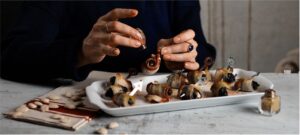
Recipe: Plums with bacon, sweet paprika and almonds
1- Stone the plums, place them in a bowl and soak them with rum: let them stand for at least half an hour, stirring occasionally so that they soak evenly;
2 – Lightly toast the almonds in the oven until just golden;
3 – Place an almond in the centre of each plum, then wrap in the bacon and close with a toothpick;
4 – Once you have finished with all the plums, place them in a baking tray lined with baking paper and sprinkle generously with sweet paprika;
5 – Bake in a preheated oven at 200 °C for about 10 minutes. As soon as the bacon becomes crispy and golden brown, remove from the oven, add a little more paprika and serve immediately.
Bacon and apple, on the other hand, are the stars of these rolls that can be made in five minutes on the clock, but are perfect for important tables where the eye also wants its part.
Recipe: Bacon and apple cider rolls
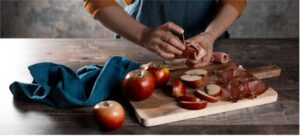
1 – Cut the meat slices into rectangles of about 5 cm x 6 cm, flour them lightly and set aside;
2 – Wash the apples and cut them into wedges without peeling them, remove the core and hard parts instead;
3 – Place a slice of open bacon on the work surface, place a slice of floured meat on top, matching one of the ends, then fold the bacon so that it covers the meat on top as well;
4 – Place an apple slice in the centre and close the roulade, securing it with a toothpick;
5 – Heat the extra-virgin olive oil in a frying pan, as soon as it is hot, place the roulades in it, brown for a minute then turn, pour in the cider, season with salt and pepper and add the thyme; 6 – Leave to cook for 2-3 minutes with the lid on, turn off and serve immediately.
Then there remains the surprise dish, the one that everyone will probably ask for the recipe or take a photo of, the ham and fig cheesecake. “We are all used to considering only the sweet version of cheesecake. In reality, it is easy to turn the tables and so we imagined a delicate but savoury version with a rosemary-flavoured biscuit base and a creamy fresh goat’s cheese filling that would enhance the love marriage between the prosciutto and figs to the fullest,’ concluded Di Marco.
This recipe is guaranteed to make a great impression: you can easily prepare it in advance and decorate it later when you bring it to the table. The figs wrapped in prosciutto will be irresistible and the balsamic vinegar glaze will do the rest. If you cannot find figs, you can replace them with pears, peaches or even fresh dates.
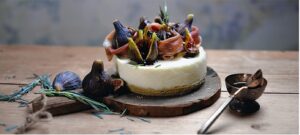
Recipe: Savoury cheesecake with figs and ham
1 – First prepare the base: in a blender, blend the biscuits with the walnuts and rosemary at high speed until a homogeneous powder is obtained;
2 – Melt the butter in a small saucepan, taking care that it does not darken;
3 – Mix the biscuit powder with the melted butter and pour it all into the bottom of a hinged mould 15 centimetres in diameter, previously lined with baking paper;
4 – With the back of a spoon, level the surface to obtain a covering of uniform thickness and then store in the refrigerator;
5 – Then prepare the filling: in a small bowl mix two tablespoons of water with the agar agar, then add the mixture to the crème fraîche trying to avoid lumps;
6 – Place on a gentle heat and as soon as it starts to warm incorporate the cheese;
7 – Stir carefully with the aid of a whisk until boiling, then pour into the hinged baking tin;
8 – Refrigerate again for 4-5 hours. When it is time to serve, open the hinge of the baking tin, unmould the cheesecake and place it on a plate at the height;
9 – For the icing: pour the vinegar into a small saucepan and add the sugar, leave to caramelise over a low heat until syrupy;
10 – Carefully wrap the figs with the prosciutto slices, decorate the surface of your masterpiece and top with the balsamic vinegar glaze.
